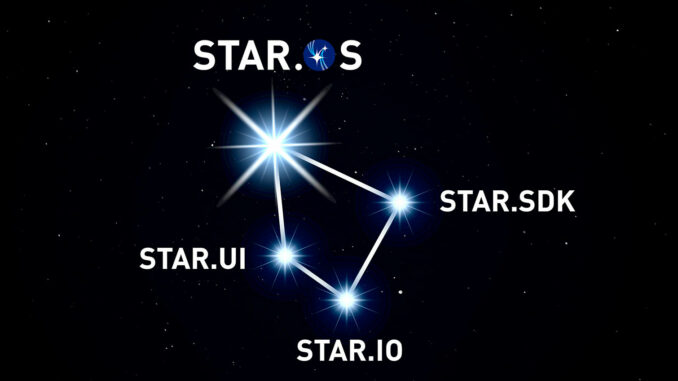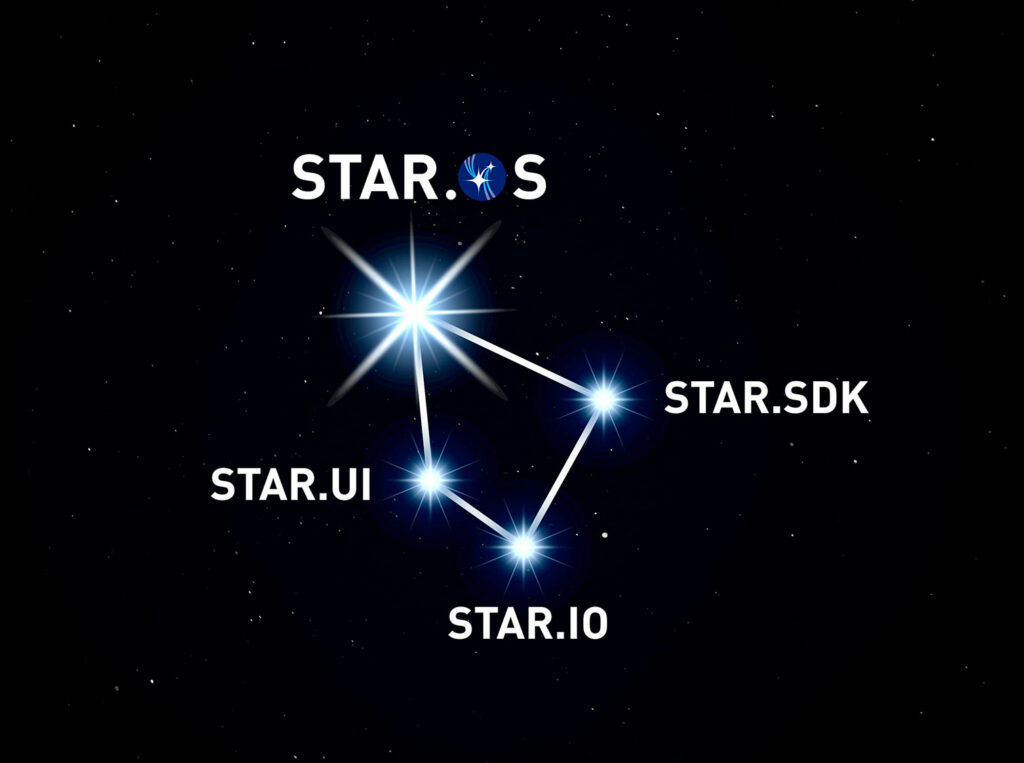
Lockheed Martin introduces STAR.OS™, a unified AI platform that brings together systems, tactical applications, autonomy, and rapid deployment to modernize defense.
Summary
Lockheed Martin launched its new AI integration platform, STAR.OS™, in November 2025. This solution addresses major interoperability challenges: connecting separate AI systems, rapidly deploying capabilities, and providing a single interface for the operator. It consists of three main components: STAR.SDK™, for rapid development of AI services; STAR.IO™, for AI interoperability; and STAR.UI™, for real-time supervision. With this architecture, the company aims to transform the way AI is used in air, land, sea, and space applications. The first uses cited include detection of threats at sea and missile alerts. By offering a unified framework, Lockheed Martin gives itself a strategic advantage: simplifying integration, reducing costs, and creating a network effect for military and civilian customers. This marks a key step in the modernization of defense AI systems, compared to previously siloed architectures.
The concept and innovation behind STAR.OS™
The STAR.OS™ (Systems, Tactical applications, Autonomy/AI, Rapid deployment) platform is presented as a unified framework for the integration of artificial intelligence systems. It addresses a recognized problem: many AI solutions in the defense sector operate autonomously, without fluid communication between them. STAR.OS™ makes it possible to group, connect, and make these disparate capabilities visible.
Among the innovative features, it should be noted that the platform is not limited to simple software: it combines a development kit (STAR.SDK™) for creating “AI services,” an interconnection layer (STAR.IO™) for linking these services, and a user interface (STAR.UI™) that provides operators with a real-time view of automated processes.
Another innovative feature is the speed of deployment. Lockheed Martin says that the architecture significantly reduces the time between the development of a new AI capability and its operational deployment. This time saving is particularly critical in a context of evolving threats.
Technical operation and platform architecture
The technical structure of STAR.OS™ consists of three main modules:
- STAR.SDK™: This is a set of tools for developers. It standardizes interfaces, provides service models, and allows efforts to be focused on AI functionality rather than integration aspects.
- STAR.IO™: This layer acts as a “universal translator” for existing AI systems. It enables heterogeneous services to communicate, exchange data, and cooperate toward a common goal.
- STAR.UI™: The operator interface. It provides a consolidated, real-time view of AI services. Engineers and operators can track data flows, analyze performance, and intervene.
Technically, the architecture includes a data bus, service management modules (micro-services), standardized APIs, a secure runtime, and flexible orchestration. It is designed to operate in highly demanding environments (air, sea, cyber) and to integrate with existing C4ISR systems, ships, bases, drones, and satellites.
Thanks to this modularity, a new AI capability (e.g., a target recognition or threat prediction algorithm) can be developed in a matter of weeks, tested and then deployed via STAR.SDK™, connected to the ecosystem via STAR.IO™, and monitored via STAR.UI™. This contrasts with traditional cycles, which can take several months or years.
Uses and areas of application
Lockheed Martin cites several initial operational uses for STAR.OS™. For example, in the areas of maritime threat detection and missile warning, the platform has already been used to combine multiple AI services into a single mission scenario.
In concrete terms, a ship can utilize: an AI radar reconnaissance service, an AI satellite imagery analysis service, a data fusion service, and a tactical recommendation service. All of these are connected via STAR.OS™ to produce an improved situational awareness, with little human intervention.
In the air domain, the platform can act as a layer behind aircraft, drones, or command systems to provide decision support, targeting, or multi-platform coordination functions. Having a common framework facilitates the integration of new sensors, mission AI, or allied systems.
In cyber and network, the orchestration capability allows intrusion detection, automated response, and crisis management AI modules to be nested in a single flow. Here again, the unification offered by STAR.OS™ is an advantage.
Beyond the defense sector, Lockheed Martin says the platform is available to private sector customers and industry partners, suggesting potential uses in critical infrastructure, maritime security, disaster response, and network protection.

The advantage for Lockheed Martin and its customers
For Lockheed Martin, STAR.OS™ represents a strategic competitive advantage. First, the platform enables the company to offer a comprehensive portfolio of AI for defense: not just algorithms or sensors, but an integration framework. This enhances Lockheed’s added value as an end-to-end systems integrator.
Second, by offering a modular and standardized architecture, Lockheed reduces its own integration costs, speeds up industrialization, and can better monetize related services (licenses, maintenance, updates). This creates a ripple effect: the more users adopt STAR.OS™, the more the base of components and services expands, strengthening the Lockheed ecosystem.
For customers—armed forces, government institutions, large critical enterprises—the benefits are manifold:
- Reduced implementation time: designing and connecting new AI capabilities becomes faster.
- Increased flexibility: customers can choose from different AI services and combine them according to the mission, without having to start from scratch.
- Improved interoperability: ability to integrate allied or legacy systems without rewriting everything.
- Visibility and control: thanks to STAR.UI™, operators have real oversight of AI behavior, which is crucial for trust and compliance.
For example, in a multinational naval mission, a customer can use STAR.OS™ to deploy AI services from different allies, combine them, and obtain a consistent joint maritime surveillance tool. This reduces technological silos and facilitates inter-allied efforts.
Impact compared to other AI technologies and the challenge of interoperability
One of the main barriers to the widespread adoption of AI in defense is limited interoperability: each system is often designed for a specific use, with proprietary interfaces, and does not “talk” to others. STAR.OS™ specifically targets this shortcoming. Several analysts believe that this platform could become a de facto standard for military AI architectures.
In comparison, other integration technologies exist but are often limited to a specific domain (e.g., air or cyber) or manufacturer. The fact that Lockheed is targeting multi-domain use (air, sea, land, cyber, space) with an extensible architecture is a key advantage.
In addition, the acceleration of AI deployments requires frameworks for governance, oversight, and explainability (explainable AI). STAR.UI™ incorporates an AI visualization and assistance element to enable human operators to understand and adjust. This responds to a growing demand from defense customers.
Finally, in a period of rapid AI evolution, having a framework capable of updating, integrating, and fielding new capabilities without re-engaging the entire architecture is a major asset. Competitors will be forced to offer similar solutions or integrate with this type of ecosystem.
Limitations and challenges associated with STAR.OS™
Although STAR.OS™ offers clear advantages, several challenges are worth highlighting.
First, although the platform is advertised as available, concrete use cases and deployment volumes remain limited to date. It will be necessary to observe how it performs on a large scale in contested environments (cyber, electronic warfare, information warfare).
Second, the issue of data security and robustness against attacks remains central. A unified architecture can become a point of vulnerability if it is not properly isolated and protected. Customers will need to ensure that STAR.OS™ meets rigorous standards of resilience and cybersecurity.
Finally, adoption by large institutions will depend on the ability to migrate legacy systems to this platform, which will require re-engineering, training, and interfacing. This could slow down the expected network effect.
Lockheed Martin’s STAR.OS™ platform illustrates a significant transformation in the way artificial intelligence is integrated into military systems. It paves the way for a coherent, multi-sensor, multimodal, multi-platform AI architecture that is adaptive and faster to implement. The challenge for the armed forces and defense players is now to successfully transition from promises to operational capabilities. For Lockheed Martin, this is a step toward consolidating its role as an integrator and reference ecosystem. The future of defense AI may well be defined by those who master not only the algorithm, but also complete integration.
Sources
– Lockheed Martin, “Lockheed Martin Revolutionizes AI Integration with STAR.OS™,” November 6, 2025.
– Lockheed Martin – Capabilities page, “The STAR.OS™ Solution.”
– ExecutiveBiz, “Lockheed Martin Launches STAR.OS to Integrate AI Systems,” November 7, 2025.
– SpaceWar via SpaceDaily, “STAR OS provides unified architecture for integrating AI systems across defense domains,” November 7, 2025.
– Defence-industry.eu, “Lockheed Martin introduces STAR.OS to improve integration of AI systems for defense applications.”
War Wings Daily is an independant magazine.